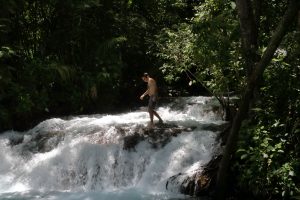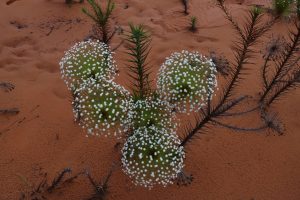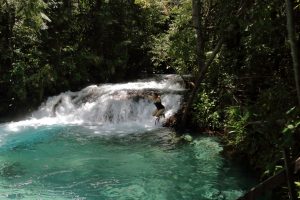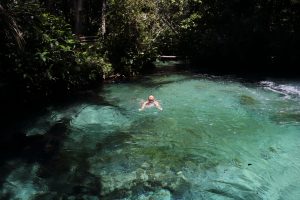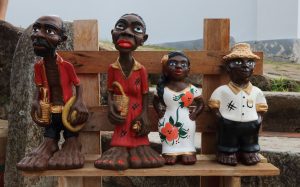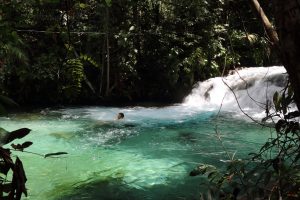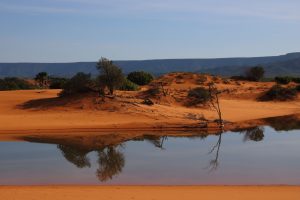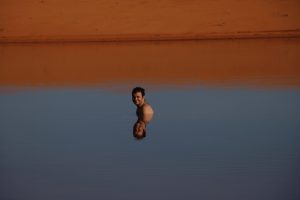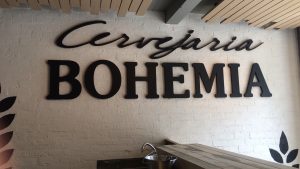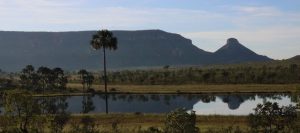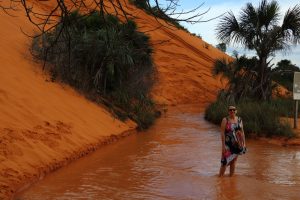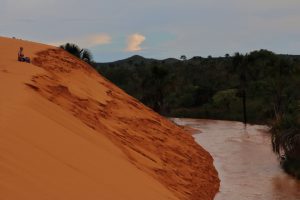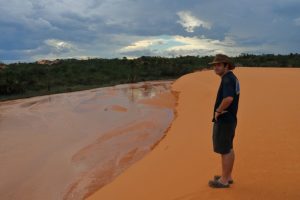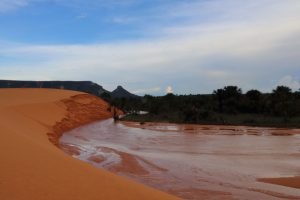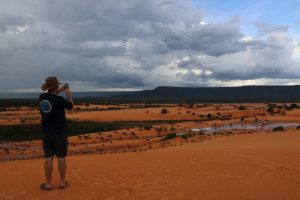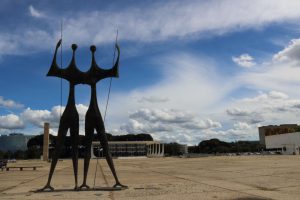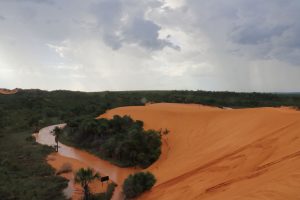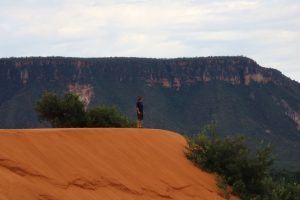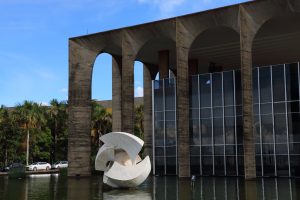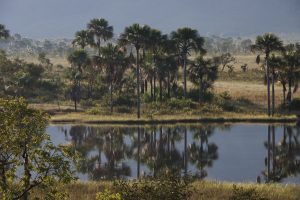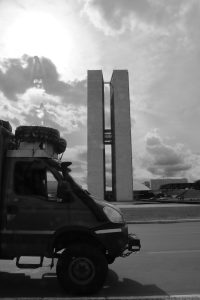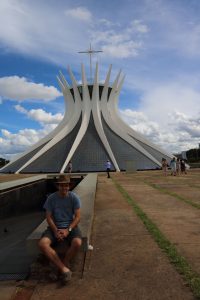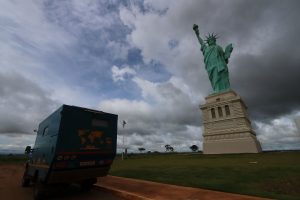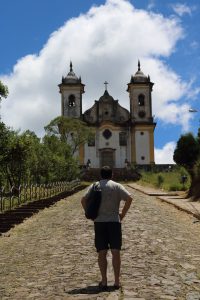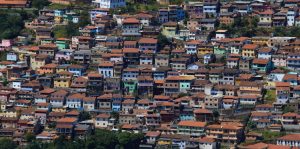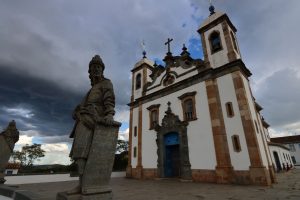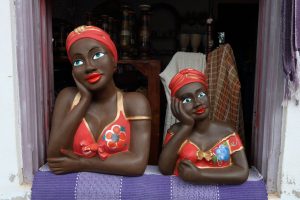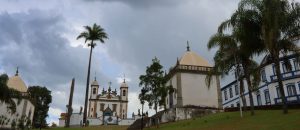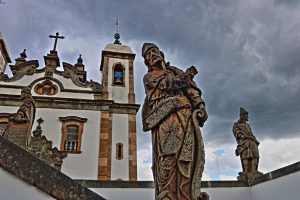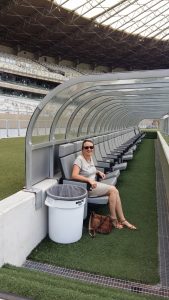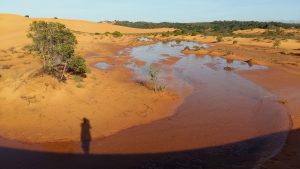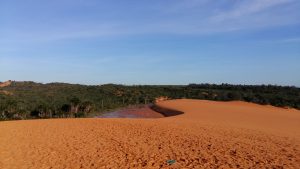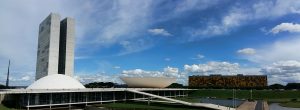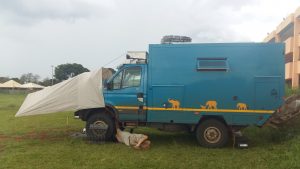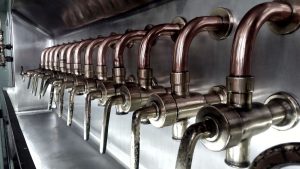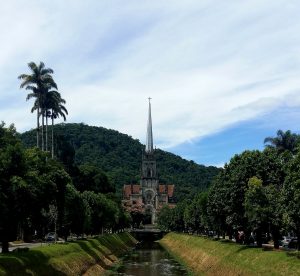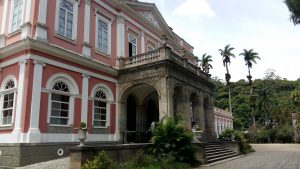A brewery, a palace, a gold mine, a football stadium, a police selfie, a floating angel, broken glow-plug, a desert lagoon and a foot swallowing sand-bubble. Our last post saw Rio and fab beaches, now we’re on a mission to see the great mix of middle Brazil, with the added dilemma of so much to see, so little time!

Imperial Petropolis
Who knew that Brazil ever had its own royal family? We didn’t. Actually, it was an off-shoot from the Portugese crowd who scarpered here fleeing the Napoleonic invasion. Prince Dom Pedro liked it here so much that in 1822 he declared independence from Portugal and bagged himself the rather grand title of Emperor of Brazil. Nice work if you can get it. During their reign, the imperial family acquired a fabulous summer palace in Petropolis on the cooler high ground behind Rio, which is now an interesting museum. The super-shiny polished mahogany floors require us to don some soft slippers, ostensibly to protect the floor, but in practice we enjoy precarious entertainment skidding from room to room, buffing the floor with the slippers as we go.
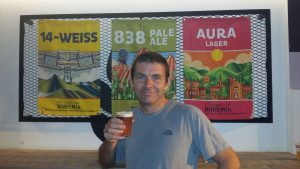 Interesting as the imperial palace is, the real attraction for us in Petropolis is the Bohemia Brewery museum. Bohemia is a popular beer in Brazil and one of the country’s oldest brands. We learn about the history of the brewing industry generally, the Bohemia brand in particular, the science and the art of beer making and the state of the global brewing and micro-brewery industry today. Then there are of course the generous samples of the products which start even before you have left the ticket desk! Luckily, we had found an overnight park-spot nearby so that we could stagger back to Cuthbert after the event.
Interesting as the imperial palace is, the real attraction for us in Petropolis is the Bohemia Brewery museum. Bohemia is a popular beer in Brazil and one of the country’s oldest brands. We learn about the history of the brewing industry generally, the Bohemia brand in particular, the science and the art of beer making and the state of the global brewing and micro-brewery industry today. Then there are of course the generous samples of the products which start even before you have left the ticket desk! Luckily, we had found an overnight park-spot nearby so that we could stagger back to Cuthbert after the event.
Gold and slaves
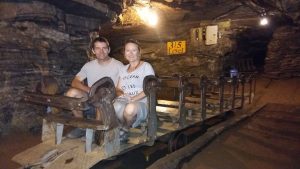 Back into Cuthbert, we do quite a long tootle up the road further inland to historic Ouro Preto. Distances are big in Brazil and we get nowhere quickly in Cuthbert! Ouro Preto’s quaint shops and houses are set on calf-achingly steep cobbled town-streets but are nevertheless worth a wander, particularly some of the many (many) churches which are literally around every street corner. Nearby we visit the defunct gold mine on which the town’s history is based (sadly, no free samples here!) At the mine we put our lives in the hands of a tiny, rickety, steam-powered cable-train and descend steeply 120m down an old shaft. In the miles of hacked-out tunnels we learn about the techniques and the huge scale of the gold operation in its day, from which the Portugese King took a large share.
Back into Cuthbert, we do quite a long tootle up the road further inland to historic Ouro Preto. Distances are big in Brazil and we get nowhere quickly in Cuthbert! Ouro Preto’s quaint shops and houses are set on calf-achingly steep cobbled town-streets but are nevertheless worth a wander, particularly some of the many (many) churches which are literally around every street corner. Nearby we visit the defunct gold mine on which the town’s history is based (sadly, no free samples here!) At the mine we put our lives in the hands of a tiny, rickety, steam-powered cable-train and descend steeply 120m down an old shaft. In the miles of hacked-out tunnels we learn about the techniques and the huge scale of the gold operation in its day, from which the Portugese King took a large share.
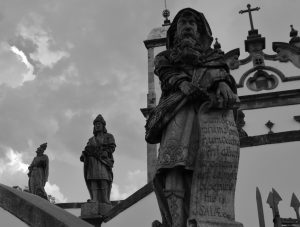 The gold mines are the reason why so many slaves were brought to this area and it was an appalled Princess Isabella (her of the imperial palace back in Petropolis) who eventually secured their emancipation. Unfortunately, she gave little thought to what these ‘free’ slaves would do following their release. Suddenly, Brazil had thousands of ‘free’ men, all homeless, jobless and penniless. They flocked down to the coast to the ‘promised land’ of Rio de Janeiro where their communities formed the early beginnings of what are now still the crime ridden favelas. A tragic episode in history, but one which has contributed in making Brazil one of the amazing cultural melting-pots that it is today.
The gold mines are the reason why so many slaves were brought to this area and it was an appalled Princess Isabella (her of the imperial palace back in Petropolis) who eventually secured their emancipation. Unfortunately, she gave little thought to what these ‘free’ slaves would do following their release. Suddenly, Brazil had thousands of ‘free’ men, all homeless, jobless and penniless. They flocked down to the coast to the ‘promised land’ of Rio de Janeiro where their communities formed the early beginnings of what are now still the crime ridden favelas. A tragic episode in history, but one which has contributed in making Brazil one of the amazing cultural melting-pots that it is today.
Also near Ouro Preto is the town of Congonhas with its 12 remarkable sculptures of the prophets, carved in soapstone around 1800 by local boy Aleijadinho. He had lost his fingers to some mystery disease but continued his work with tools strapped to his arms. The quality of the life-sized figures would be remarkable for any Tom, Dick or Harry sculptor, but they’re even more amazing under the circumstances. Impressive.com.
The Beautiful Game
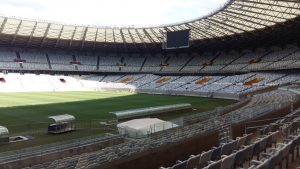 Next stop on the inland odyssey is Belo Horizonte, one of Brazil’s major modern cities and home to two of the country’s top football teams: Atletico Mineiro and Cruzeiro. On non-match days their stadium is open for guided tours. To be honest, our knowledge and interest in football is limited to recognising David Beckham in an underpants advert, but even for sporting luddites like us, the tour gives a fascinating insight into the sport generally, the stadium’s construction in 1965 (plus its extensive renovation for the 2014 World Cup) and the behind-the-scenes operations of a 63,000 seater venue. The slight ‘fly in the ointment’ for the stadium’s illustrious history is that it was here where Brazil suffered its humiliating defeat 7-1 by Germany in 2014. Very much not their finest hour, but given England’s extraordinarily poor performance that same year, we’re really not in any position to mock here 🙂
Next stop on the inland odyssey is Belo Horizonte, one of Brazil’s major modern cities and home to two of the country’s top football teams: Atletico Mineiro and Cruzeiro. On non-match days their stadium is open for guided tours. To be honest, our knowledge and interest in football is limited to recognising David Beckham in an underpants advert, but even for sporting luddites like us, the tour gives a fascinating insight into the sport generally, the stadium’s construction in 1965 (plus its extensive renovation for the 2014 World Cup) and the behind-the-scenes operations of a 63,000 seater venue. The slight ‘fly in the ointment’ for the stadium’s illustrious history is that it was here where Brazil suffered its humiliating defeat 7-1 by Germany in 2014. Very much not their finest hour, but given England’s extraordinarily poor performance that same year, we’re really not in any position to mock here 🙂
Capital Police Encounter
After another very long tootle even further inland (did we mention that Brazil is quite big?) we reach the purpose-built capital city. Designed from scratch by Oscar Niemeyer in the 1950s, Brasilia took Brazil’s seat of power from Rio de Janeiro in 1960.

Brasilia is said to be a city of its time, but I think it is actually a city reflecting what one forward-thinking architect thought at that time, would be a city of the future. Wandering around the city with its symmetrical layout, its buildings of modern shapes and clean-lines and lots of green spaces between them, I get the distinct feeling that back in a time when the end of the 20th Century seemed a long way off, Brasilia was designed to reflect Niemeyer’s idealistic prediction of how all modern cities would (should?) look by the futuristic Year 2000. Niemeyer lived until 2012 and the ripe old age of 105, so he did survive to see how his designs stood the test of time.
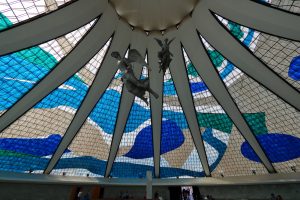 One the alleged ‘must-see’ tourist-ticks of Brasilia is the monument bearing the eternal flame. Unfortunately, we find said flame to be not so eternal and it looks as though its eternity ended some time ago. After visiting the not-so-eternal flame, we wander back to Cuthbert and two police officers approach us “You’re Julie and Marcus… right?” OMG… what on earth have we done? 🙁 “We looked at your blog-page… we love Cuthbert” Phew… the website is written on the truck! Diana and Rodrigo turn out to be the friendliest cops in Brazil and insist on taking a selfie to share on Facebook. Later we see that the PR department of the Tourist Police of Brazil is also sharing the pic on their official FB page. Brilliant!
One the alleged ‘must-see’ tourist-ticks of Brasilia is the monument bearing the eternal flame. Unfortunately, we find said flame to be not so eternal and it looks as though its eternity ended some time ago. After visiting the not-so-eternal flame, we wander back to Cuthbert and two police officers approach us “You’re Julie and Marcus… right?” OMG… what on earth have we done? 🙁 “We looked at your blog-page… we love Cuthbert” Phew… the website is written on the truck! Diana and Rodrigo turn out to be the friendliest cops in Brazil and insist on taking a selfie to share on Facebook. Later we see that the PR department of the Tourist Police of Brazil is also sharing the pic on their official FB page. Brilliant! 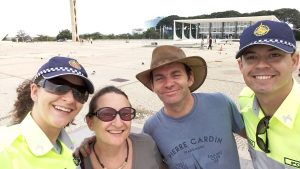
Glow-plug extraction
Just before Brasilia, Cuthbert had passed his milestone 120,000 km, so parked-up in a quiet field behind the city’s Youth Hostel seems as good a place as any for Marcus to do Cuthbert’s routine health-check. The 120K is a biggie service, so it’s going to take a couple of days. There’s quite a lot of rain at the moment, so Marcus erects a make-shift tent over Cuthbert’s bonnet to work in the dry. Ingenious! All goes well except that one of the glow-plugs refuses to come out of its hole (yes, I’ve got all the technical jargon here 🙂 ) and needs a special tool to extract it. We take Cuthbert to a nearby workshop, but have you ever tried explaining such a task in Portugese? We find the only way to clarify the issue is for Marcus to strip the engine in front of the mechanic to physically show him the problem, but the chap concludes that we’re unlikely to find such a tool in Brasilia. Helpfully, he suggests that we might find such a tool in Sao Paulo maybe. Yeah… thanks for that… it’s only 1,000 km away!!! In the end, Marcus decides that we can carry the snag for now. It’s only likely to be a problem in very cold weather and we’re not going to see any of that for a loooong time!
Park-life: Jalapão and Chapada Diamantina
One of the dilemmas we have in Brazil is so much to see, so far to travel, so little time! As Brits we don’t need a visa here, but we can spend only 90 days in any six month period in the country. We have allocated this as 60 days to cover over 9,000 km up to the French Guiana border, then when we return to Brazil from British Guyana, we will have 30 days left to get across the middle of the Amazon jungle to exit into Peru. This, for us, is an unusually tight schedule and we have to decide which of Brazil’s many amazing sights we stop to see on the way.
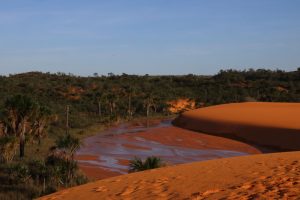
Over 800km north of Brasilia (another long tootle up the road) is the national park of Jalapão. It’s remote, and the last 100km to reach it are on rough tracks. But we are reliably assured by locals in Brasilia that it’s the up-and-coming, destination-of-choice for adventurous Brazilians and far less touristy than the popular Chapada Diamantina Park over to the east. They show us beautiful photos on their phones of desert dunes with sparkling fresh-water lagoons; waterfalls into natural swimming holes with crystal-clear turquoise water. Okay… they convince us… we’re doing an 800km detour to see Jalapão.
 Luckily for us, it turns out to be even better than the photos had shown. It’s stunning! Jalapão is essentially a 4×4 destination, but truly worth the effort to get there and really should become a regular destination for overlanders exploring Brazil. We’ve tried to back this up with our own pictures, but we still don’t think we have quite done justice to this exquisitely beautiful place. Jalapão is definitely one of our highlights in Brazil, if not the whole of South America so far.
Luckily for us, it turns out to be even better than the photos had shown. It’s stunning! Jalapão is essentially a 4×4 destination, but truly worth the effort to get there and really should become a regular destination for overlanders exploring Brazil. We’ve tried to back this up with our own pictures, but we still don’t think we have quite done justice to this exquisitely beautiful place. Jalapão is definitely one of our highlights in Brazil, if not the whole of South America so far.
One fascination phenomenon that occurs in the park is a series of water-pools called ‘fervedouros’. In these small, idyllic looking, fresh-water pools, water is permeating up in vertical shoots from the ground through the sandy floor and creating a natural jacuzzi effect. It really cool to swim above the bubbling sand, but it’s even weirder when you put your foot onto the bubbles and you sink-in, losing your leg into the void below. So bizarre!
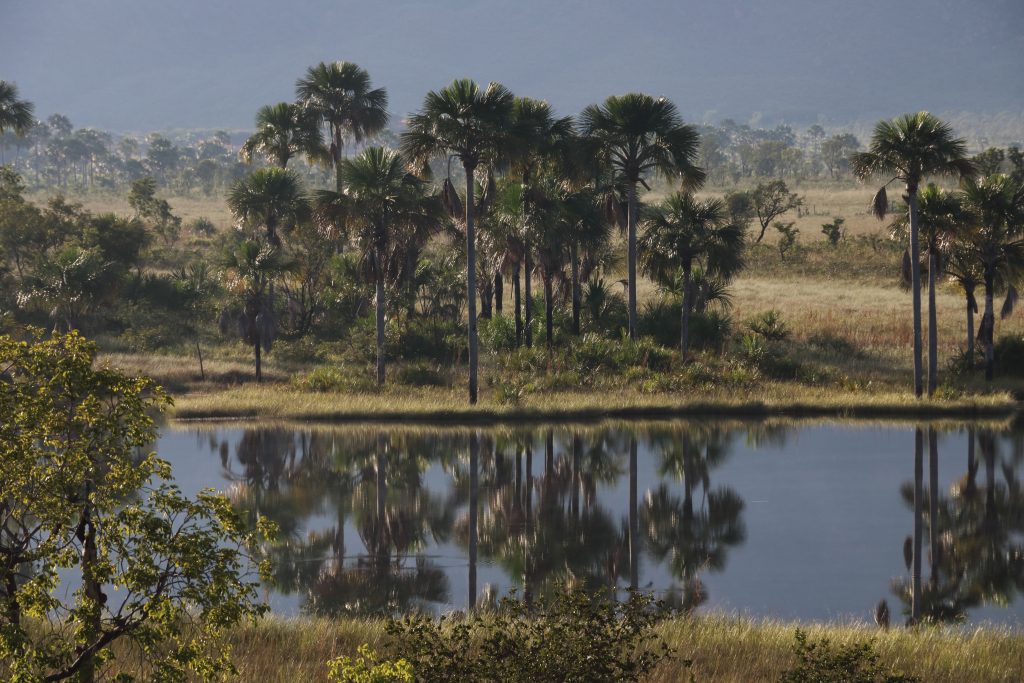
After Jalapão we’re heading east finally back towards Salvador on the coast. En-route we’ll be passing the much-visited park of Chapada Diamantina, so it would be churlish not to stop by and say hello. Chapada Diamantina is indeed very beautiful and we can see why it is so popular; we enjoyed a couple of short walks there and some lovely natural swimming holes. But having now seen them both, we’re very happy that we took the advice and focussed our park-time on Jalapão. One day no doubt, Jalapão will become as popular as Chapada Diamantina, but for now we feel privileged to have seen something special in the heart of Brazil that few tourists take the time to see.
Now we’re heading the last few hundred kilometres eastwards back to the coast. Tune in soon for the city port of Salvador and our coastal trip north.
Link to next blog: Brazil: Tudo Bom! Link to full South America Blog

